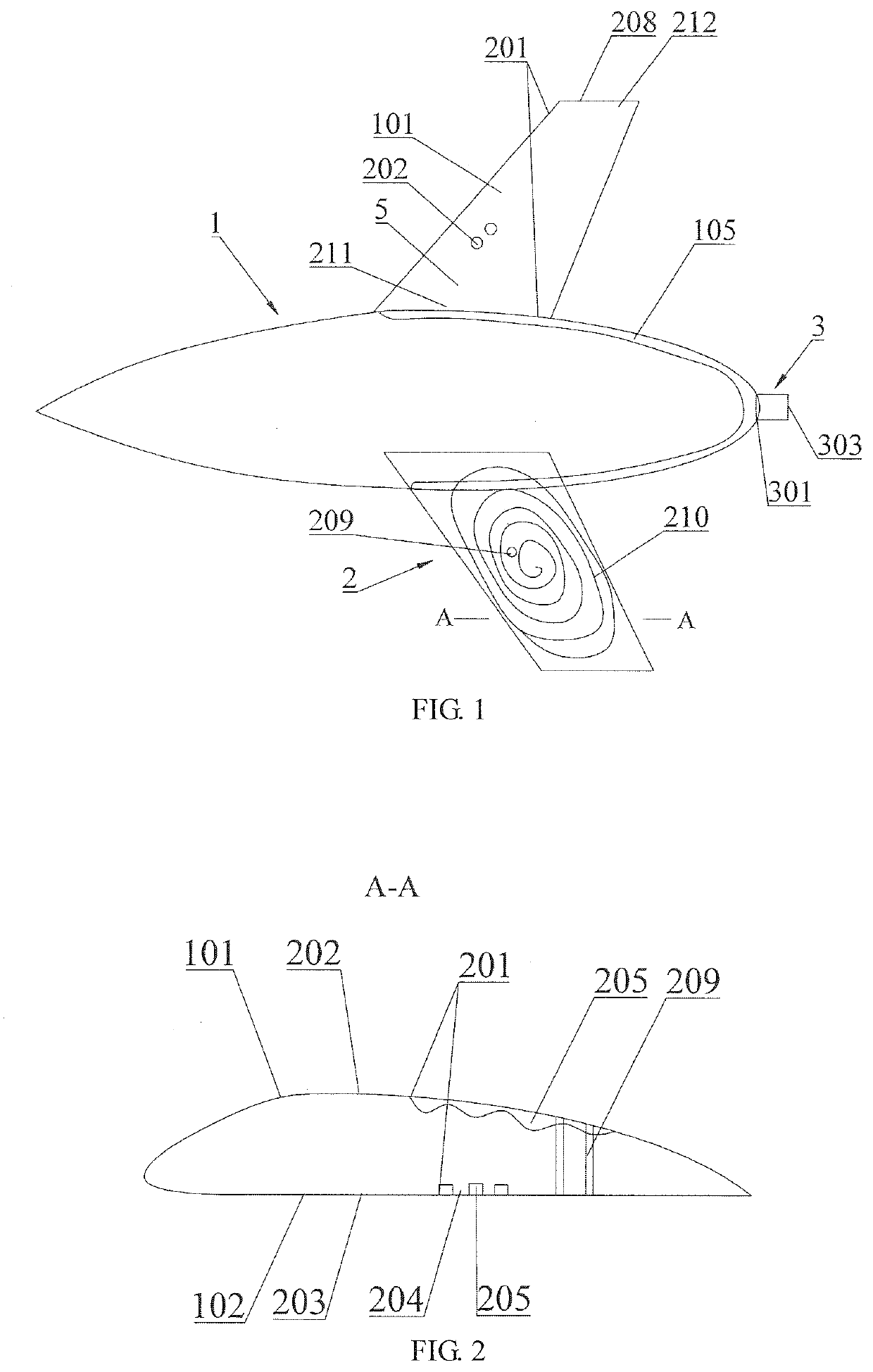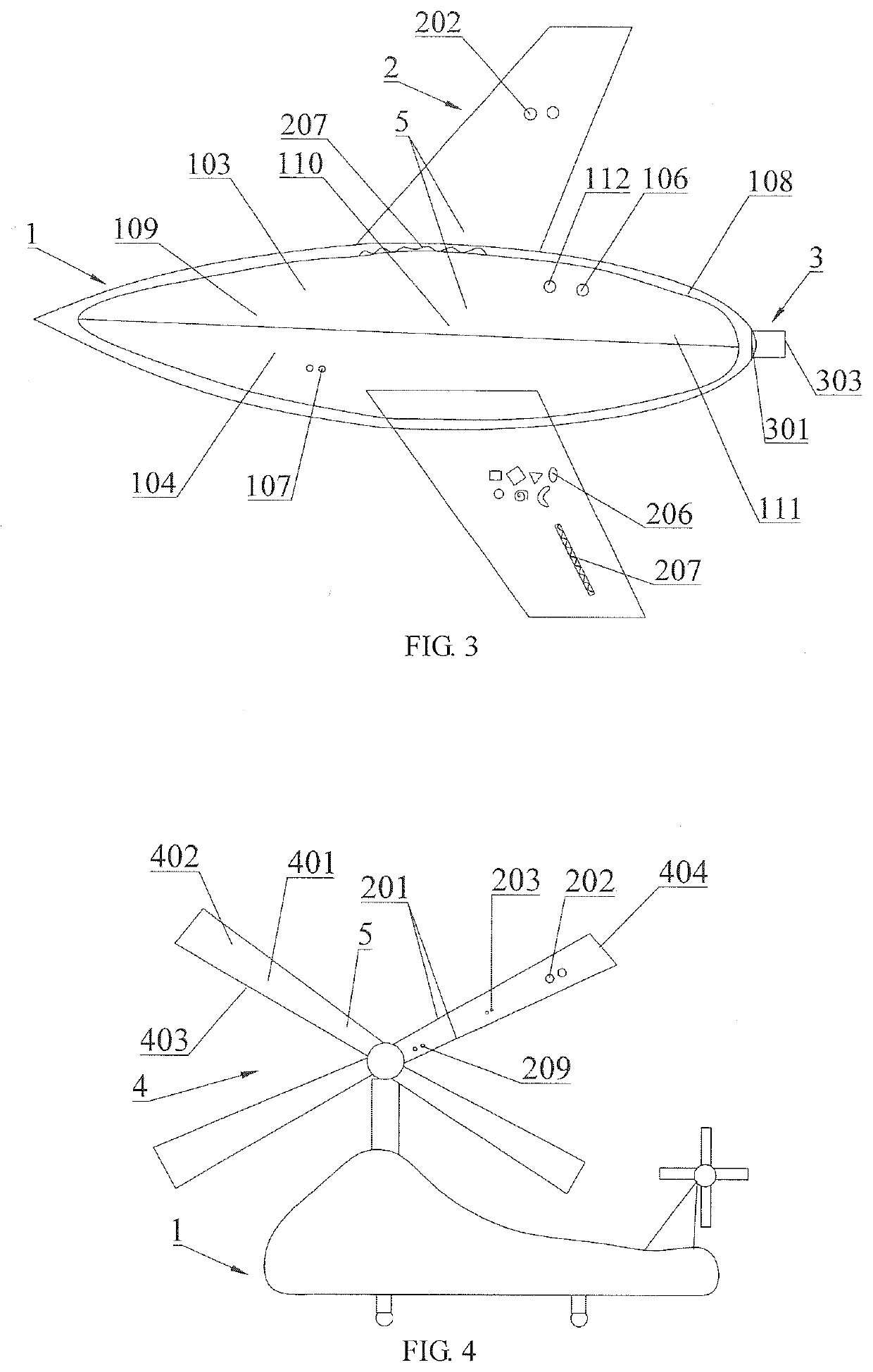Aircraft generating larger lift by reduction of fluid resistance
a technology of fluid resistance and aircraft, applied in the field of aircraft, can solve the problems of only about 10% of the energy utilization rate of the moving device, and the moving device consumes about 90% of the power
- Summary
- Abstract
- Description
- Claims
- Application Information
AI Technical Summary
Benefits of technology
Problems solved by technology
Method used
Image
Examples
embodiment 1
[0027]Referring to FIG. 1-FIG. 3, an aircraft comprises a fuselage 1 and wings 2, wherein a plurality of first pressure ports 203 (small holes) are formed in lower surfaces 102 of the wings and are communicated with first channels 201 in the wings 2, first inlets 202 are uniformly formed in upper surfaces 101 of the wings from roots 211 of the wings to tails 212 of the wings and are communicated with the first channels 201, first outlets 208 are formed in the tails of the wings 2 and are communicated with the first channels 201, and fluid flows through the wings in a lengthwise direction and is discharged via the first outlets 208 at the tails; spoiler devices are arranged in the first channels 201 of the wings to extend the paths of the fluid flowing through the first channels in the lengthwise direction of the wings and are located on a side towards the upper surfaces 101 or a side towards the lower surfaces 102, and the spoiler devices are arranged in part of the first channels ...
embodiment 2
[0040] this embodiment differs from Embodiment 1 in that a plurality of rows of first inlets 202 are uniformly formed in the upper surfaces 101 of the wings from roots 211 to tails 212 in the lengthwise direction and are communicated with the first channel 201, so that two high-speed fluid layers 5 which are communicated with each other and have approximately identical flow speeds are formed by the upper surfaces of the wings and the first channel 201 to guide the fluid to flow through the upper surfaces of the wings in the lengthwise direction. A plurality of rows of pressure pipes 209 (small holes) are uniformly on the lower surfaces 102 of the wings in the widthwise direction and are communicated with the upper surfaces of the wings (fluid naturally flows through the upper surfaces and lower surfaces of the wings in the widthwise direction); under the fluid continuity, the fluid flows through the upper surfaces 101 of the wings in the lengthwise direction and flows through the lo...
embodiment 3
[0042] as shown in FIG. 3, this embodiment differs from Embodiment 1 in the following aspects: the fuselage 1 comprises an upper half 103 and a lower half 104, a third channel 108 is formed in a shell around the fuselage 1, a plurality of second inlets 106 are uniformly formed in the upper half of the fuselage and are communicated with the third channel 108, and a plurality of second pressure ports 107 are uniformly formed in the lower half of the fuselage and are communicated with the third channel 108. The opening area of the second inlets 107 is larger than that of the second pressure ports 107, and spoiler devices are arranged in the third channel 108 corresponding to the upper half 103 of the fuselage to extend the fluid path and to increase the flow speed, so that high-speed fluid layers 5 are formed in the shell of the upper half 103 of the fuselage and the corresponding third channel 108, a pressure difference is generated due to different flow speeds of the high-speed fluid...
PUM
 Login to View More
Login to View More Abstract
Description
Claims
Application Information
 Login to View More
Login to View More - R&D
- Intellectual Property
- Life Sciences
- Materials
- Tech Scout
- Unparalleled Data Quality
- Higher Quality Content
- 60% Fewer Hallucinations
Browse by: Latest US Patents, China's latest patents, Technical Efficacy Thesaurus, Application Domain, Technology Topic, Popular Technical Reports.
© 2025 PatSnap. All rights reserved.Legal|Privacy policy|Modern Slavery Act Transparency Statement|Sitemap|About US| Contact US: help@patsnap.com


